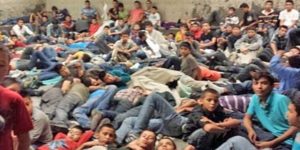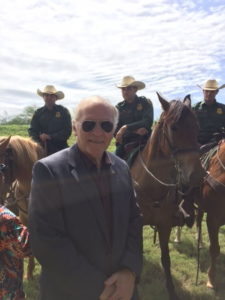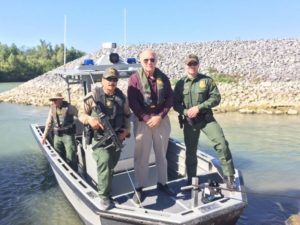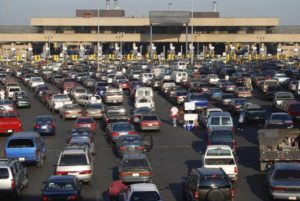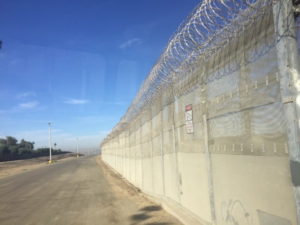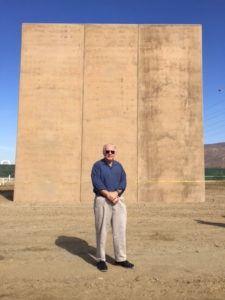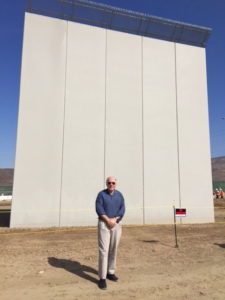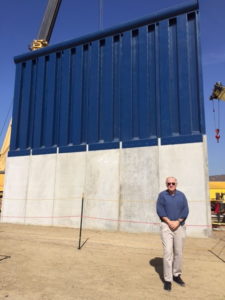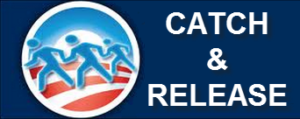Two days ago, I set my alarm at the ungodly hour of 4 AM so I could catch a 6 AM flight from Cincinnati to Houston, and then another flight to McAllen, Texas. There I linked up with three other Members of the House Judiciary Committee: Chairman Bob Goodlatte of Virginia, Congressman Steve King of Iowa (both Republicans like me), and Congresswoman Sheila Jackson-Lee of Texas, a Democrat. (Her Houston district was recently devastated by Hurricane Harvey.)
The purpose of our excursion to the Texas/Mexican border was meeting with our first line of defenders there, the U.S. Border Patrol. We started out at the Rio Grande Valley Centralized Processing Center, which is where you probably saw news coverage a few summers back when thousands and thousands of “unaccompanied minors” flooded into the United States from Guatemala, Honduras, and El Salvador, via Mexico. The numbers are down substantially from what we saw a few years ago, but they’re still processing approximately 50,000 illegal aliens every year at this one Texas center.
We then met with the Border Patrol’s famed horse patrol which can operate in the roughest terrain imaginable. Interestingly, 36 of 39 horses are mustangs, which are free-roaming horses of the American west, descended from horses first brought here by the Spanish about 500 years ago. Because they are used to the harshest of conditions, they can withstand 10-hour work days with little water, and temperatures often exceeding 100 degrees for many hours. The horses were beautiful, and their riders just as impressive, perfectly capable of chasing down “runners” when warranted.
We then traveled down the Rio Grande on Border Patrol boats. One side of the river is the United States; the other side Mexico. The Border Patrol agents occasionally pointed out “spotters”, people on the Mexican side, usually young males, who would inform coyotes (those guiding groups of illegals across the border), when it was safe to cross over into the U.S.
We concluded the Texas part of the trip at the Hidalgo Port of Entry, where 12 lanes of traffic are screened coming into the U.S. (There are also an average of 8,000 pedestrians daily who pass over there as well.) The Border Patrol at this point is looking mainly for drugs, although also for contraband, terror threats, and of course illegal immigrants.
Monday evening we flew to San Diego, California where we completed our border tour Tuesday (yesterday.) The U.S. Border Patrol there took us along the border between San Diego and Tijuana, Mexico, where the border is double fenced, with the taller of the two barriers being 18 feet high, with razor sharp concertina wire along the top. Can illegal immigrants climb over it? Yes, with a 19 foot ladder – and they throw a mattress over the concertina wire.
Trump’s wall, which I by the way support, would be 30 feet tall, and laddering over such an imposing structure would be difficult (although not impossible.) We were taken to a demonstration project, currently under construction, where they have a half-dozen prototypes built. There are a number of companies competing for the contract, so we can get the best price possible for the taxpayers. Here are several photos of me standing in front of three of the prototypes. (I’m about 6 feet tall, and they’re 30.)
You also may have heard that Mexican drug cartels have been building tunnels under the border to smuggle in drugs, and sometimes, although rarely, people. Drug cartels apparently have a saying “narcotics don’t talk, but people do.” The idea being that if illegals they’ve smuggled in get caught, they might talk, and the smugglers lose a very valuable asset – the tunnel. So smuggling drugs into the U.S. is their preferred use of the tunnels.
The tunnels can be anywhere from a few hundred to 3,000 feet in length, and they’re usually down 60-90 feet below the surface. We crawled down a ladder 90 feet deep and saw one of the tunnels that had been discovered by the Border Patrol up close and personal. (It was harder climbing back up the 90 foot ladder than it was going down!)
In the interest of respecting your time, I’ll end with a few quick points. Point one, I talked to a lot of Border Patrol agents – off the record. Overwhelmingly they feel that the Trump Administration has their back, unlike the Obama Administration. For example, they were very frustrated with Obama’s “catch and release” policy whereby agents picked up illegals and often let them go. Trump ended that policy. And it’s having positive results.
Point two, more and more illegals when picked up at the border are claiming “asylum.” They’re being told by their coyotes (the drug cartel escorts actually smuggling them across the border) to claim they are fearful for their lives in their home country. Too many hearing officers are routinely finding “credible fear”, and are allowing them to stay in the U.S. This loophole has to be tightened.
Point three, sanctuary cities, and now an entire sanctuary state, California, is making the enforcement of our immigration laws tougher than it ought to be. One of the Border Patrol officials told me that in California, for example, many of the illegal immigrants are receiving welfare and other public assistance. But California officials refuse to cooperate with federal immigration enforcement officials in disclosing what addresses the welfare checks are going to, so the border officials could locate the illegals. Outrageous.
And finally, Trump’s right about building a wall. It won’t be foolproof, but it will dramatically increase security at our southern border. I’m convinced it’s money well spent (whether Mexico pays for it or not.)



